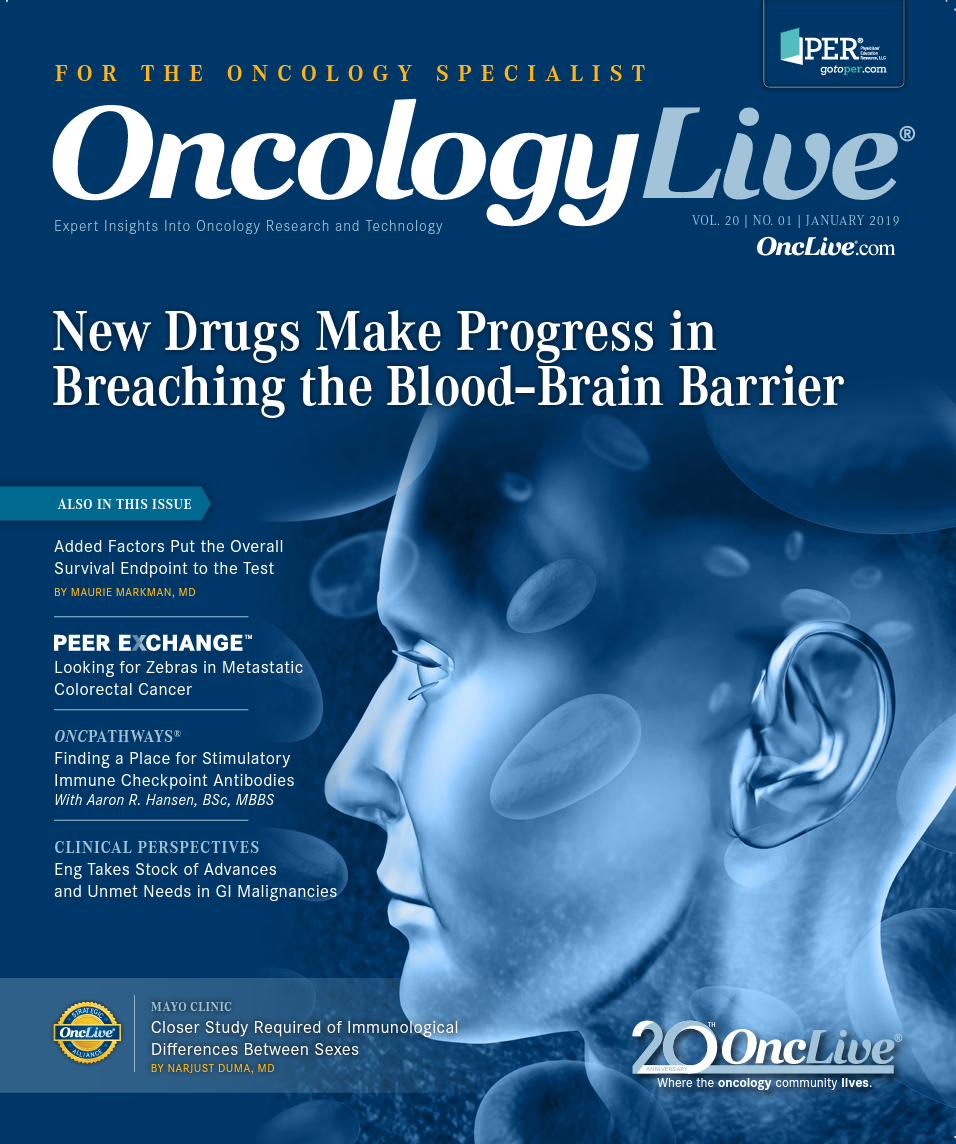Added Factors Put the Overall Survival Endpoint to the Test
The impact of subsequent lines of treatment on trial outcomes can be substantial, seriously challenging the relevance of OS as an objectively meaningful study endpoint.

Maurie Markman, MD
The debate continues: How can a new antineoplastic agent be approved for marketing if it has not been demonstrated in at least 1 well-designed phase III randomized clinical trial to offer a statistically significantly overall survival (OS) advantage? Is it possible to disagree with the simple logic that this endpoint must be the major aim of all antineoplastic agents, to improve the survival of patients receiving the drug? After all, isn’t this what patients want to achieve, the greatest possible duration of survival?
Further, the thinking goes, with the staggering increases in the costs of therapeutic cancer drugs, a new agent should simply not be permitted to enter the commercial market unless it has been documented to improve survival. The economist may rationally argue that merely prolonging the time until the next adverse event develops or an imaging study reveals an increase in the size of an existing small tumor mass should not be a sufficient reason for a manufacturer to be permitted to charge patients and third-party payers $10,000 to $15,000 or more per month for a new drug.
I don’t disagree with the premise that improving survival is a critically relevant aim of antineoplastic drug therapy, but I do vigorously challenge the notion that this highly meaningful outcome can be supported by the OS endpoint of phase III randomized trials. Although it is not difficult to provide strong evidence to support this conclusion, in this brief commentary, I can highlight only a few clinically relevant examples.
We begin with the recently reported experience associated with ALK mutation—positive non–small cell lung cancer and the delivery of crizotinib (Xalkori), a highly active agent that was approved for this indication in 2014.1 Previously published data from an international, multi center, phase II randomized trial revealed the progression-free survival (PFS) superiority of this agent to standard-of-care chemotherapy (pemetrexed [Alimta] with cisplatin or carboplatin) in the patient population whose cancer exhibited this relatively uncommon (2%-6% incidence) molecular abnormality (HR, 0.45; median PFS, 10.9 vs 7.0 months).2 The objective response rate was also greater following treatment with this targeted therapeutic agent. However, in the final OS analysis (median follow-up, 46 months) published 4 years after the FDA approval, there was no statistically significant difference between the 2 therapeutic strategies (HR, 0.760; P = .0978). Survival at 4 years was 56.6% in patients randomized to the crizotinib arm of the trial and 49.1% in individuals receiving chemotherapy.2
It is significant that 75% of the individuals (128 of 171 patients) randomized to initial treatment with chemotherapy subsequently crossed over to receive the targeted therapeutic agent following disease progression.2 The data suggest a substantial proportion of these individuals achieved clinical benefit resulting in an improvement in their ultimate survival, which made it impossible to document a statistically significant improvement in OS based on the initial treatment regimen assignment. The bottom line is that both patient populations experienced a survival benefit because most individuals within the 2 groups ultimately received crizotinib (either as first-line or later therapy).
Perhaps the most striking example of a trial-arm crossover that negated the utility of an antineoplastic investigative study for demonstrating a definitive statistically significant OS outcome can be found in the landmark phase III randomized trial in chronic-phase chronic myelogenous leukemia. This compared imatinib (Gleevec) with the standard of care at that time of cytarabine plus interferon-α.3,4 Crossover to imatinib from the less-effective (and more toxic) standard-of-care study arm occurred relatively quickly (64% of patients after a median duration of 9 months of treatment), which made the study incapable of demonstrating an improvement in OS for the imatinib trial arm.3,4 Subsequently conducted alternative statistical analyses and population-based data have clearly documented highly impressive survival benefits associated with the use of imatinib,3-5 but for the reasons stated, these were not observed within the confines of the formal intention-to-treat analysis of the randomized phase III trial.
An interesting experience associated with 2 ovarian cancer clinical trials conducted with the rigor mandated for drug regulatory approval provides another provocative view of the impact of subsequent lines of therapy on OS.6,7 The studies in question were initiated 8 years apart (1999 and 2007) but had 1 identical study arm (carboplatin plus gemcitabine). The eligibility for entry, platinum-sensitive recurrent ovarian cancer, was also the same in both trials, and although cross-trial comparisons are always of concern because patient populations may differ in meaningful ways despite similar requirements and patient characteristics, in this specific case, it is notable that the 2 carboplatin/ gemcitabine study arms reported essentially identical PFS outcomes (median 8.6 months for the earlier and 8.4 months for the later trial).
Despite this observation, there was a most striking difference in OS associated with treatment with essentially the identical carboplatin/ gemcitabine regimen. In the trial initiated in 1999, the median OS was 18.0 months,6 while the survival endpoint for the same regimen in a study initiated only 9 years later was 35.2 months.7 Of course, although it is difficult to be certain why this almost doubling of OS was observed, it is likely that the outcome resulted from the impact of more effective treatment options available during this later period compared with the clinical trial started in 1999.
Again, the point here is that the impact of subsequent lines of treatment on trial outcomes can be substantial, seriously challenging the relevance of OS as an objectively meaningful study endpoint.
References
- Malik SM, Maher VE, Bijwaard KE, et al. U.S. Food and Drug Administration approval: crizotinib for treatment of advanced or metastatic non-small cell lung cancer that is anaplastic lymphoma kinase positive. Clin Cancer Res. 2014;20(8):2029-2034. doi: 10.1158/1078-0432.CCR-13-3077.
- Solomon BJ, Kim DW, Wu YL, et al. Final overall survival analysis from a study comparing first-line crizotinib versus chemotherapy in ALK-mutation-positive non-small-cell lung cancer. J Clin Oncol. 2018;36(22):22512258. doi: 10.1200/JCO.2017.77.4794.
- Roy L, Guilhot J, Krahnke T, et al. Survival advantage from imatinib compared with the combination interferon-alpha plus cytarabine in chronic-phase chronic myelogenous leukemia: historical comparison between two phase 3 trials. Blood. 2006;108(5):1478-1484. doi: 10.1182/blood-2006-02-001495.
- Hockhaus A, Larson RA, Guilhot F, et al; IRIS Investigators. Long-term outcomes of imatinib treatment for chronic myeloid leukemia. N Engl J Med. 2017;376(10):917-927. doi: 10.1056/NEJMoa1609324.
- Bower H, Björkholm M, Dickman PW, Höglund M, Lambert PC, Andersson TM. Life expectancy of patients with chronic myeloid leukemia approaches the life expectancy of the general population. J Clin Oncol. 2016;34(24):2851-2857. doi: 10.1200/JCO.2015.66.2866.
- Pfisterer J, Plante M, Vergote I, et al; AGO-OVAR; NCIC CTG; EORTC GCG. Gemcitabine plus carboplatin compared with carboplatin in patients with platinum-sensitive recurrent ovarian cancer: an intergroup trial of the AGO-OVAR, the NCIC CTG, and the EORTC GCG. J Clin Oncol. 2006;24(29):4699-4707. © JEMASTOCK/ADOBE STOCK doi: 10.1200/JCO.2006.06.0913.
- Aghajanian C, Blank SV, Goff BA, et al. OCEANS: a randomized, double-blind, placebo-controlled phase III trial of chemotherapy with or without bevacizumab in patients with platinum-sensitive recurrent epithelial ovarian, primary peritoneal, or fallopian tube cancer. J Clin Oncol. 2012;30(17):2039-2045. doi: 10.1200/JCO.2012.42.0505.




